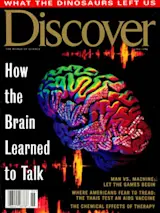I always had this weird idea that I had to know lots of different things, says a faintly uncomfortable Marty Sereno. He shifts in his chair, turning his back to a Post-it-fringed computer screen and a table so deep in open journals that it looks like the cross-bedded planes of a geologic formation. Sereno is sitting in his office at the University of California at San Diego, where drawn miniblinds shut out the distracting southern California sunshine. When you’re trying to do interdisciplinary stuff, he continues, it’s no good putting two specialists together in a room, because they can’t talk to each other. You’ve got to pretend you’re in the other field; you have to go and live with the natives. It has to be all in one head.
To understate the case considerably, the 40-year-old Sereno has a lot of things in one head. There is his primary research ...














